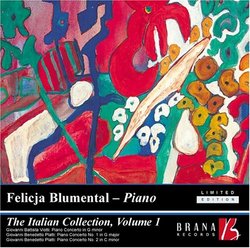| All Artists: Giovanni Viotti, Giovanni Benedetto Platti, Theodore Guschlbauer, Alberto Zedda, Torino Symphony Orchestra, Salzburg Symphony Orchestra, Felicja Blumental Title: The Italian Collection, Volume 1 Members Wishing: 0 Total Copies: 0 Label: Brana Records Original Release Date: 1/10/2005 Release Date: 1/10/2005 Genre: Classical Styles: Forms & Genres, Concertos, Historical Periods, Baroque (c.1600-1750), Classical (c.1770-1830), Instruments, Strings Number of Discs: 1 SwapaCD Credits: 1 UPCs: 803680439654, 821158102527 |
Search - Giovanni Viotti, Giovanni Benedetto Platti, Theodore Guschlbauer :: The Italian Collection, Volume 1
 | Giovanni Viotti, Giovanni Benedetto Platti, Theodore Guschlbauer The Italian Collection, Volume 1 Genre: Classical
There is often a tendency to think of composers such as Bach, Mozart and Beethoven as titanic geniuses who entered the world fully-formed, musical heavyweights of such stature that they stand alone in history. But, of cour... more » |
Larger Image |
CD Details
Synopsis
Album Description
There is often a tendency to think of composers such as Bach, Mozart and Beethoven as titanic geniuses who entered the world fully-formed, musical heavyweights of such stature that they stand alone in history. But, of course, there were countless composers who enjoyed local and international fame in their lives but have been undeservedly hidden by the long shadow cast by the musical titans. This disc of concertos by Viotti and Platti brings back into the light concertos by two who deserve a place in the pantheon of composers of immense talent, energy and no little influence on some the greats who followed them. Giovanni Battista Viotti - Piano Concerto in G minor Viotti is chiefly remembered for elevating performing standards to a high artistic level and as one of the crucial figures in the development of modern violin playing. He was also the first to realise the musical value of Stradivari?s violins and to prove as much to his audiences and to posterity. Many of these instruments played and introduced by Viotti himself have been passed down through generations of virtuosi and remain in the hands of today's star players, such as Pierre Amoyal. Viotti's 29 violin concertos are by far the most satisfying of his works, both artistically and historically. Not only are they inventive vehicles for technical display, enough to test any soloist, but are testament to his brilliant musical imagination. For the first time in this genre, the full resources of the violin and orchestra are gradually being brought into play. Influences from Parisian musical life in the 1780s add operatic drama and symphonic breadth to these concertos. Presented here in a reworking for piano by the German pianist and composer Daniel Steibelt, Viotti?s attractive and forceful personality shine through his Concerto No.19 in G minor, composed towards the end of his decade in Paris. The scope is huge for its day: dark, dramatic passages mingle with filigree fingerwork, bold statements and delicate note-spinning reminding us both of Viotti?s Classical base and of his influence on Beethoven and his contemporaries - and even, at times, taking us further! , into the dramatic light and shade of the German Romantic spirit of Mendelssohn and Weber Giovanni Benedetto Platti Piano Concerto No. 1 in G major Piano Concerto No. 2 in C minor Just as Viotti?s active musical life was sandwiched between the great composers of the Classical era, so Giovanni Benedetto Platti (before 1692 ? 1763) had the misfortune to be around when the titans of the Baroque era - Bach, Handel, Rameau and Domenico Scarlatti ? bestrode their age. The goal of most composers at this time was to secure a decent living in the courts of the nobility, and this is exactly what Platti did, moving from Italy to enter the service of the Prince-Archbishop of Bamberg and Würzburg. Little is known of his life before he entered into service in 1722, but there are hints that his teachers may have included both Albinoni and Vivaldi. At the Prince-Archbishop's court Platti seems to have been a master of a good many trades including singing, playing the harpsichord, violin, cello, flute and oboe in performances of compositions by himself and others. The job of a court musician was, naturally, to reflect the sophistication and respectability of courtly life and the magnificence and munificence of his lord and master. Platti's compositions range from church music, including a masterly Requiem, through numerous concertos to sonatas for various combinations of instruments. The two keyboard concertos presented here make fascinating listening. They are beautifully wrought three movement pieces where the keyboard is moving toward the Classical concerto's genuine solo role, while their structure and orchestral texture remain with one foot firmly in the Baroque camp. The slow movements display sensitively written parts for the performer which may well serve to illustrate Platti's apparent contact wit

 Track Listings (9) - Disc #1
Track Listings (9) - Disc #1